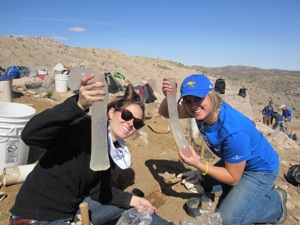Editor's note: A topic discussed in detail at America's Summit on the National Parks earlier this year was how to get youth into the parks. In a series of stories, the Traveler is looking at the approaches different groups take to address that issue. In this, the fourth installment in the series, we hear from a Student Conservation Association volunteer, Oliwia Baney, who spent her spring break working at Joshua Tree National Park. Her essay was written the week before she headed to Joshua Tree.
I was scared.
I admit it.
The weathered rocks, the sneering wind, the indifferent sun. It was my first time in the Mojave Desert.
I stood alone, small, searching in vain for any sign of human influence, and I suddenly became painfully aware of my own insignificance. This stark yet stunning territory had already experienced more than I ever could if I lived one hundred lifetimes. I was humbled, awed and, yes, a little fearful.
Yet even as I grappled with these strafing emotions, I began to feel a new and different sensation. The pure patience of the landscape was infectious and soon I no longer felt I was an intruder, but rather an accomplice. By participating with the earth, I became part of something greater. The desert broke me down and then built me back up. I am stronger now, and eager to return the favor.
Next week over spring break, I will work at Joshua Tree National Park with 29 other college students with the Student Conservation Association, eradicating invasive species and contributing to the ultimate goal of sustaining this unique ecosystem.
As a member of a generation widely believed to be self-absorbed and detached from the natural world, I would like to offer an alternative perspective to the purported norm. Millennials, as others have labeled us, struggle to differentiate ourselves from the vast amount of the data out there. We sell ourselves on Facebook, doing everything possible, often to the extreme, just to make ourselves stand out from the crowd.
This mindset helps drive our celebrity culture, and motivates the pursuit of hollow fame and the anonymous adoration of a million faceless followers. It’s not only virtual, it’s vapid.
When you take a standard eye exam, there is a fascinating machine called a phoropter. It’s the one with multiple lenses, which the optometrist flips through to a series of distinctive sounds. First lens, the letters on the poster are indistinct blurs. Click. Hey, now you can actually see what they are. Click. Oh, this one's even better. Click. In an instant, everything is perfectly clear, the little black letters standing at full attention on the wall.

The SCA volunteers used a gelatinous compound they place around the newly planted seedling to help feed it moisture in the desert sun/heat. SCA photo.
I likewise find that with every new experience, I gain a new perspective, a new lens through which to view the world and all that I would not have noticed without it.
This kind of seeing – of being – retains its meaning over time. The more we participate in our natural world, the more real and tangible it becomes. And the more we become a part of it.
In an era of efficiency and shortcuts, the value of hard, honest work is in danger of losing its meaning. Similarly, concepts such as limited resources lack true context to a comparatively sheltered generation.
These may have been appropriate motivators for our parents or grandparents, but unfortunately they simply do not resonate as well with Generation Y. What does speak to us, however, are our connections, our presence and position within the greater dynamics of a community.
This makes us a powerful, if paradoxical, force. Our desire for recognition doesn’t make us selfish – it makes us want to matter. And service to the community and the environment forges just this kind of connections we require.
For all our obsessions with individuality, we also have an intense fear of isolation. But the awesome truth is, we are not alone at all. We share a small earth with countless other inhabitants, and my generation wants, needs to believe that what we do makes a difference.
This is why there are college students who, after the mentally exhausting drag of finals, are willing to spend their spring break working long days in a hot desert. And this is why when I return to the Mojave, I will not suffer the anxieties of my first visit. I will not suffer at all. I will celebrate. No matter how many lenses I flip through, I still see the enormous potential of my generation.
We are hardly the apathetic heirs of climate change and abused wilderness, but rather on the brink of seizing our role in a complex but thriving system that needs our care and attention.
No matter how I look at it, it's all in focus.
Oliwia Baney is a first year student at UCLA studying microbiology. Her Alternative Spring Break at Joshua Tree National Park is conducted by the Student Conservation Association and sponsored by American Eagle Outfitters.


 Support Essential Coverage of Essential Places
Support Essential Coverage of Essential Places







Comments
Oliwia-- You sound like a great person!! Enjoyed your essay--glad to know people like you are part of the next generation to carry on!